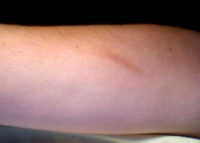
If you have a scar, you might want to show it off to display your bravery or tell a funny story. Scars are a natural part of your body’s healing process after a skin injury. But even if a wound seems to have healed into a scar, there’s still a lot going on under the surface of your skin that you should be aware of.
The Healing Process
Scars can take up to a year to heal completely, with most of the process occurring out of sight. In most cases, the scar will turn from pink to white as the scar heals. The skin will also flatten out in the affected area. This happens because bodies produce scar tissue to mend the damage that has happened. Scar tissue is comprised of collagen fibers that help the body repair itself. The body doesn’t always produce the right amount of scar tissue, though:
- Hypertrophic scars are a result of too much scar tissue production. These scars are raised but do not expand beyond the boundaries of the wound.
- Keloid scars are also the product of collagen overproduction. Larger than a hypertrophic scar, keloids swell beyond the initial wound and can become itchy, red and painful.
- Atrophic scars stem from underproduction of scar tissue. When not enough collagen is produced to counteract the loss of tissue from the original injury, the scar can appear depressed. These scars appear like a small indentation in the skin.
Scars can also result from burns. Burn scars look different from others, and are thick and bound down in the skin.
How are scars treated?
Not all scars require treatment, but in cases of too much or too little scar tissue generation, treatments exist to make the scars look less noticeable.
- Lasers: Pulsed dye and resurfacing lasers are two types of lasers that we use to reduce the size and redness of scars. Lasers are often used to treat burn scars. Treatment for these burn scars becomes less effective as more time passes between the incident and the treatment.
- Injectable steroids and chemotherapy agents can work to flatten out scars that have risen into bulky lumps.
- Atrophic scars require treatments that will help the scar fill itself in. Resurfacing lasers are one tactic we use to address this issue. Another is micro-needling, which helps to stimulate collagen production by creating imperceptible puncture wounds on the top layer of the skin.
You should generally avoid putting tension of the affected area of your skin for a few months until the wound is fully repaired. Scars that become infected can cause the scar to become inflamed and irritating. Topical silicone creams are among the best ways to treat scars, improving the appearance of the blemish within 3-6 months.
Most scars do not pose any risk to your health or lifestyle. The most important thing to remember if you suffer a wound that will become a scar is to follow the instructions for wound care closely. If the scar becomes agitated in any way, don’t hesitate to schedule a same day or next day appointment on our website or by calling 651-209-1600.